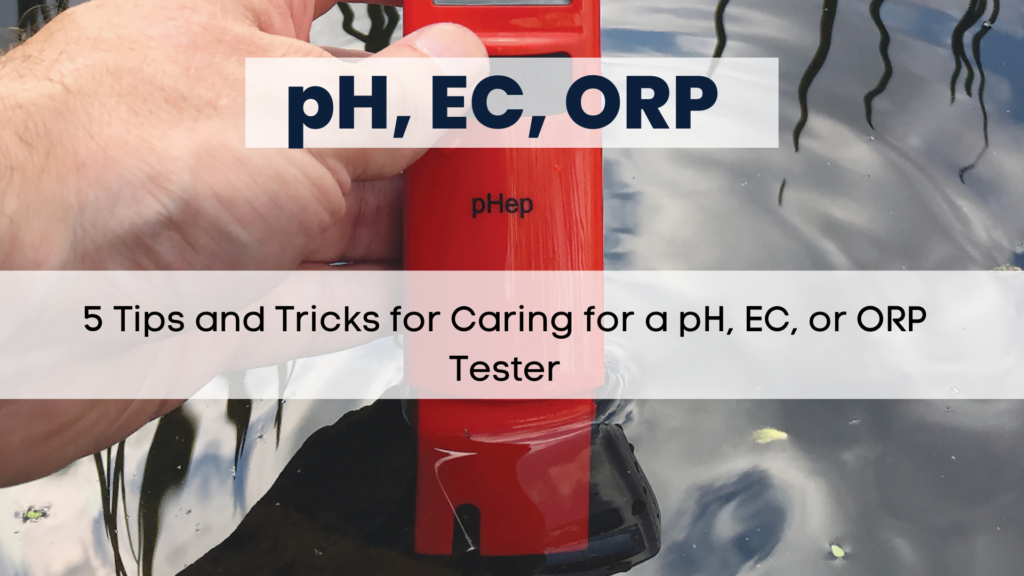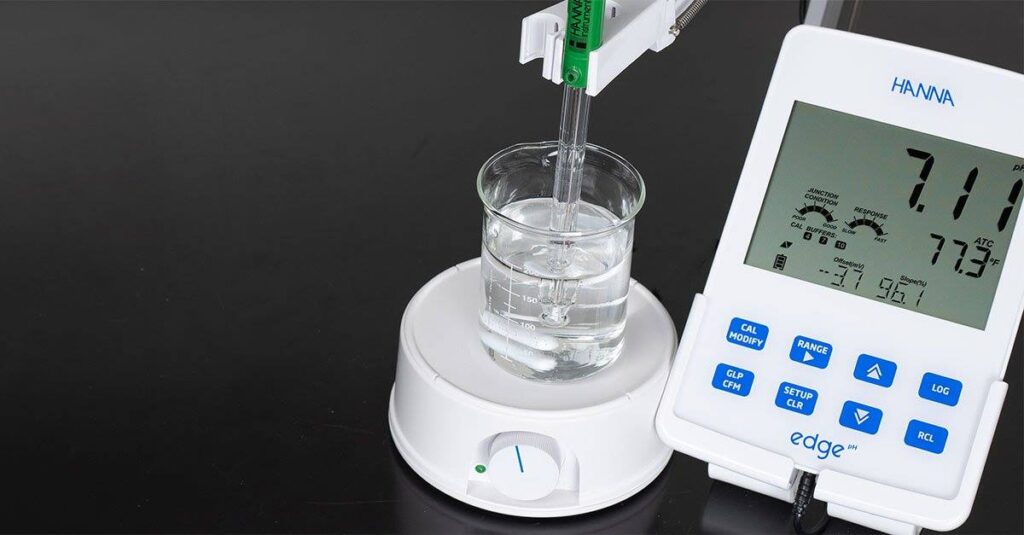
នៅពេលចាប់ផ្តើម ដំណើរការស្រាវជ្រាវ ផលិត ឬ ការវិនិយោគលើវិស័យថ្មី បញ្ហាបច្ចេកទេសដែលកើតឡើងដោយមិនបានរំពឹងទុក គឺជាអ្វីដែលមិនអាចជៀសផុតបាន។ មិនថានៅក្នុង ឧស្សាហកម្មកែច្នៃចំណីអាហារ ការត្រួតពិនិត្យទឹកអាងហែលទឹក ឬកម្មវិធីឯកទេសផ្សេងទៀត ការដំណើរការ ឧបករណ៍វិភាគ ទាមទារការរៀបចំយ៉ាងហ្មត់ចត់។
ដើម្បី សម្រួលដល់ដំណើរការ និងធានា ភាពជឿទុកចិត្តនៃទិន្នន័យ យើងខ្ញុំផ្តល់ជូននូវ ការណែនាំចាំបាច់សម្រាប់អ្នកទើបចាប់ផ្តើម អំពីរបៀប ថែទាំឧបករណ៍វាស់ ដែលជាឧបករណ៍វិភាគដ៏សំខាន់បំផុតនៅក្នុងមន្ទីរពិសោធន៍របស់អ្នក។ គោលដៅគឺជួយអ្នក ធ្វើឱ្យប្រសើរឡើងនូវប្រសិទ្ធភាព និង ពន្យារអាយុជីវិតរបស់ប្រដាប់ស្ទង់។
1. ប្រើកែវជំនួយសម្រាប់ទុកសូលុយស្យុង
ការក្រិតដែលទទួលបានជោគជ័យ គឺអាស្រ័យលើការរក្សា ភាពបរិសុទ្ធ នៃសូលុយស្យុង។
នៅពេល ក្រិតឧបករណ៍វាស់ មិនត្រូវចាក់សូលុយស្យុង ដែលបានប្រើត្រឡប់ចូលក្នុងដបដើមវិញដាច់ខាត។ ទង្វើនេះអាច បំពុល សូលយុស្យុងទាំងមូលនៅក្នុងដប ដែលធ្វើឱ្យសូលុយស្យុងត្រូវបាន លុបចោល។
ដើម្បីធានាថា Buffer តែងតែស្អាត និងរក្សាបាន ភាពត្រឹមត្រូវ, អ្នកគួរតែ ចាក់បរិមាណសមស្របមួយ ទៅក្នុង កែវតូច ឬពាងកែវតូច (ដូចជាពាងចំណីអាហារទារកដែលបានលាងសម្អាត) ហើយប្រើ Buffer ក្នុងពាងនេះដើម្បីធ្វើការក្រិត។
អ្នកអាច ប្រើសូលុយស្យុងដែលបានចាក់ប្រហែលមួយសប្តាហ៍។ បន្ទាប់ពីរយៈពេលនេះ សូមលាងសម្អាតកែវ ឬ ដបហើយជំនួសដោយសូលុយស្យុងថ្មី។
គន្លឹះរបស់ Hanna
Hanna ក៏មានផ្តល់ជូននូវសូលុយស្យុងប្រើតែម្តង ដែលងាយស្រួលប្រើ ដូចជា HI70007P (25 កញ្ចប់នៃ 7.01) និង HI77400P (5 កញ្ចប់នៃ
7.01 និង 5 កញ្ចប់នៃ
4.01) ដែលជួយ លុបបំបាត់ទាំងស្រុងនូវហានិភ័យនៃការឆ្លងមេរោគ នៅក្នុងដំណើរការក្រិត។
HI7004/1L pH 4.01 Calibration Solution
HI7007/1L pH 7.01 Calibration Solution
2. ប្រើសូលុយស្យុងរក្សារជំនាញ
ត្រូវតែផ្តល់អាទិភាពដល់ការប្រើប្រាស់ សូលុយស្យុងរក្សារជំនាញ ជំនួសឱ្យការប្រើទឹកធម្មតា ដើម្បីរក្សាទុក អេឡិចត្រូត ។
ប្រសិនបើមិនមានសូលុយស្យុងឯកទេសដូចជា Electrode Storage Solution HI70300L ទេ អ្នកអាចជំនួសដោយ សូលុយ្សុង 4 ឬ ក្នុងករណីបន្ទាន់បំផុត សូមប្រើ សូលុយ្សុង 7។
មិនត្រូវរក្សាទុកអេឡិចត្រូតនៅក្នុងទឹកម៉ាស៊ីន ឬទឹកបរិសុទ្ធ ដាច់ខាត!
ទឹកម៉ាស៊ីន ឬទឹកបរិសុទ្ធមាន កំហាប់អំបិល (អ៊ីយ៉ុង) ទាបខ្លាំង បើធៀបនឹងសូលុយ្សុងអេឡិចត្រូត្រូលីតនៅខាងក្នុងតួអេឡិចត្រូត។ ភាពខុសគ្នានៃកំហាប់នេះនឹងបង្កឱ្យមានបាតុភូត អូស្មូស៊ីស (Osmosis) ដែលបណ្តាលឱ្យទឹកផ្លាស់ទីពីតំបន់កំហាប់ទាប (ខាងក្រៅ) ទៅតំបន់កំហាប់ខ្ពស់ (ខាងក្នុងអេឡិចត្រូត)។
បញ្ហានេះនឹងធ្វើឱ្យកំហាប់អំបិលនៅខាងក្នុងអេឡិចត្រូតថយចុះ ដែល ប៉ះពាល់យ៉ាងធ្ងន់ធ្ងរដល់ភាពរសើប និង អាយុជីវិតរបស់អេឡិចត្រូត របស់អ្នក។
គន្លឹះរបស់ Hanna
ការជ្រលក់អេឡិចត្រូតទៅក្នុងទឹកក្នុងរយៈពេលខ្លីដើម្បី លាងជម្រះ សូលុយ្សុងគំរូ ឬសូលុយ្សុង Buffer គឺអាចទទួលយកបាន។ ទោះជាយ៉ាងណាក៏ដោយ មិនត្រូវស្តុកទុកអេឡិចត្រូត នៅក្នុងទឹកជាអចិន្ត្រៃយ៍ឡើយ។
3. របៀបរក្សាអេឡិចត្រូតឱ្យមានសំណើមជានិច្ច

ការរក្សា អេឡិចត្រូត ឱយមានសំណើម គឺធានាថាស្ថានភាពរបស់វានឹងនៅដដែលជានិច្ច។ ដើម្បីផ្តល់សំណើមដល់អេឡិចត្រូតរបស់អ្នក ៖
- ដាក់ម៉ែត្រឱ្យឈរត្រង់ក្នុងកែវមួយដែលមាន ទឹកសូលុយស្យុងរក្សាទុក ឬដាក់អេប៉ុងតូចមួយ (ប្រហែល 1/4 អ៊ីញ ពីអេប៉ុងផ្ទះបាយថ្មី) នៅក្នុងគម្របឧបករណ៍វាស់របស់អ្នក ហើយត្រាំអេប៉ុងនោះជាមួយសូលុយស្យុងរក្សាទុក។
ហេតុផលបច្ចេកទេស
មូលហេតុចម្បងដែលអ្នកត្រូវរក្សាអេឡិចត្រូតឱ្យមានសំណើមល្អ គឺដោយសារវាជួយឱ្យ ផ្នែកប្រសព្វ (junction) សើម។ មានតំបន់មួយនៅខាងក្នុងអេឡិចត្រូត pH នីមួយៗ ដែលអំបិល (ក្នុងទម្រង់ជាទឹក ឬជែល) ចេញទៅខាងក្រៅ និងជ្រាបចូលទៅក្នុងដំណោះស្រាយដែលកំពុងត្រូវបានធ្វើតេស្ត។ អ្វីដែលរារាំងដំណើរការនេះ នឹងបណ្តាលឱ្យលទ្ធផលវាស់មានភាពរអាក់រអួល (និងមិនស្ថិតស្ថេរ)។ ការធានាថាផ្នែកប្រសព្វសើម ហើយមិនបង្កើតជាកករនៅផ្ទៃខាងក្រៅ នឹងជួយឱ្យឧបករណ៍វាស់របស់អ្នកដំណើរការបានដូចថ្មី និងប្រើប្រាស់បានយូរអង្វែង។
4. សម្អាតអេឡិចត្រូតតាមកាលកំណត់
ជាជម្រើសល្អបំផុត គឺប្រើប្រាស់សូលុយស្យុងសម្អាតជំនាញ ដូចជា General Purpose Cleaning Solution HI7061L។ អ្នកអាចធ្វើ ការក្រិត ដើម្បីលុបបំបាត់កំហុសមួយផ្នែកក៏ដោយ ក៏ការកកើតសារធាតុមិនបរិសុទ្ធជាបន្តបន្ទាប់ នៅទីបំផុតនឹងនៅតែប៉ះពាល់ដល់លទ្ធផលវាស់ដដែល ទោះបីជាមានការក្រិតក៏ដោយ។
ការដោះស្រាយបញ្ហាប្រដាប់ស្ទង់ខូច
ប្រសិនបើ អេឡិចត្រូតមានការប្រេះស្រួច ឬ ខូចនៅខាងក្នុង ឧបករណ៍វាស់នឹងតែងតែបង្ហាញលទ្ធផល pH 7 ដោយមិនគិតពីសូលុយ្យុងគំរូ។ ប្រសិនបើអ្នកអនុវត្តតែការក្រិតមួយចំណុចនោះយើងខ្ញុំសូមណែនាំឱ្យអ្នក ត្រួតពិនិត្យអេឡិចត្រូតជាប្រចាំ ដោយធ្វើតេស្តវានៅក្នុង ទឹកខ្មេះ ឬទឹកក្រូច។ ដោយសារតែ ជាតិអាស៊ីតខ្ពស់ លទ្ធផលដែលបានអានគួរតែមាន pH 4 ឬទាបជាងនេះ។ ប្រសិនបើលទ្ធផលបង្ហាញលើសពី pH 4 នោះ ប្រដាប់ស្ទង់របស់អ្នកទំនងជាខូច។
អាយុជីវិតអេឡិចត្រូត
រឿងសំខាន់ដែលត្រូវចងចាំគឺថា អេឡិចត្រូត pH មិនមានអាយុជីវិតអចិន្ត្រៃយ៍។ អាយុជីវិតធម្មតា គឺ 1 ទៅ 2 ឆ្នាំអាស្រ័យលើ កម្មវិធីប្រើប្រាស់ និង ភាពញឹកញាប់នៃការប្រើប្រាស់។ ទោះបីជាឧបករណ៍អាចនៅតែផ្តល់លទ្ធផលបន្ទាប់ពីរយៈពេលនេះក៏ដោយ ភាពត្រឹមត្រូវ របស់វាអាចនឹងមិនត្រូវបានធានាទៀត។ ភាពញឹកញាប់នៃការផ្លាស់ប្តូរប្រដាប់ស្ទង់របស់អ្នក នឹងអាស្រ័យលើ កម្រិតភាពត្រឹមត្រូវ ដែលអ្នកត្រូវការ។
មិនថាអ្នកកំពុងធ្វើតេស្ត pH, EC, TDS ឬ ORP នៅក្នុងអាងចិញ្ចឹមត្រី ដំណោះស្រាយសារធាតុចិញ្ចឹមសម្រាប់សួនច្បារក្នុងផ្ទះ ឬទឹកនៅក្នុងអាងហែលទឹកទេ Hanna Instruments តែងតែមានឧបករណ៍ដែលសមស្របតាមតម្រូវការរបស់អ្នក។ យើងខ្ញុំផលិតនូវ ឧបករណ៍វាស់ពហុប៉ារ៉ាម៉ែត្រ ជាច្រើនប្រភេទ ដែលក្នុងនោះឧបករណ៍ដែលពេញនិយមបំផុតគឺសម្រាប់វាស់៖
- pH
- EC/TDS
- ORP
5 Tips and Tricks for Caring for a pH, EC, or ORP Tester
When you’re first embarking on a new endeavor, there a lot of unexpected things that pop up along the way. From cheese making to pool testing and beyond, your new hobby or business may come with some additional tasks that you didn’t know to plan for. We’re here to make things a little bit easier for the beginners when it comes to caring for your new best friend – your pH tester.
1. Use a small glass jar to store your buffer
Successful calibration depends on keeping the buffer fresh. When calibrating a pH meter the buffer should never be poured back in the bottle. This could contaminate the bottle, rendering your buffer useless. To keep the buffer clean and accurate, pour some into a small glass container, like a baby food jar, and use that to calibrate your meter. You can use the poured buffer for about a week. After that, wash the jar and replace it with fresh solution.
Hanna Tip: We also offers the HI70007P (25 sachets of pH 7.01) and the HI77400P (5 sachets each of pH 7.01 and 4.01), which are convenient, single use buffers.
2. Use the proper storage solution
If you’re trying to decide whether to purchase a storage solution or to store your electrode in water, it is always best to use storage solution. If a solution, such as Electrode Storage Solution HI70300L, is not available then use pH 4 buffer or, in a real pinch, pH 7 buffer. Never store in tap or purified water! Tap and purified waters are very low in salt, relative to the solution inside the electrode. The imbalance will cause the water to move from low concentration (water) to high (inside electrode) by osmosis. This affects the concentration of salt inside the electrode, and thus affects the life of your pH electrode.
Hanna Tip: It’s okay to place the electrode in water for a short period of time to rinse off a solution. Just don’t store the electrode in it.
3. Maintain a hydrated electrode
Maintaining a hydrated electrode assures you that the condition will always remain the same. To hydrate your electrode either place the meter upright in a glass with storage solution, or place a small piece of sponge (about a 1/4” cube cut from a new kitchen sponge) in the cap of your tester and wet the sponge with the solution.
The main reason you want to keep the electrode well-hydrated is that it keeps the junction wet. There’s an area inside of every pH electrode from which salt (in either a liquid or gel) migrates to the outside and seeps in the solution that is being tested. Anything that prevents this will cause readings to drift (and therefore be unstable). Ensuring that the junction is wet and doesn’t form a precipitate at the outer surface will keep your meter working newer, longer.
4. Clean the electrode periodically
Preferably you will want to use a cleaning solution such as General Purpose Cleaning Solution HI7061L. In most cases you can calibrate the error out, but eventually the growth will affect the readings regardless of calibration.
f a probe has a hairline crack or a break on the inside, the meter will always read 7 regardless of the solution. If you are only performing a single point calibration, then we suggest that you periodically check the electrode by testing it in vinegar or orange juice. Because they are acidic, you should get a reading of pH 4 or less. If the reading is over pH 4, then you likely have a broken probe.
On a final note, it’s important to remember that pH electrodes don’t last forever; the typical lifespan is 1-2 years, depending on what they’re used for and how often. A meter might still read outside of this time frame, but the accuracy could be off. How often you change your probe will depend on how accurate you need or want your reading to be.
Whether you are testing the pH, EC, TDS or ORP of your aquarium, the nutrient solution of your indoor garden, or the water in your swimming pool (the home-user, maintenance team, or installation business), Hanna Instruments carries the a device suited to your needs; we make several testers for measuring multiple parameters. Here are our most popular ones:
